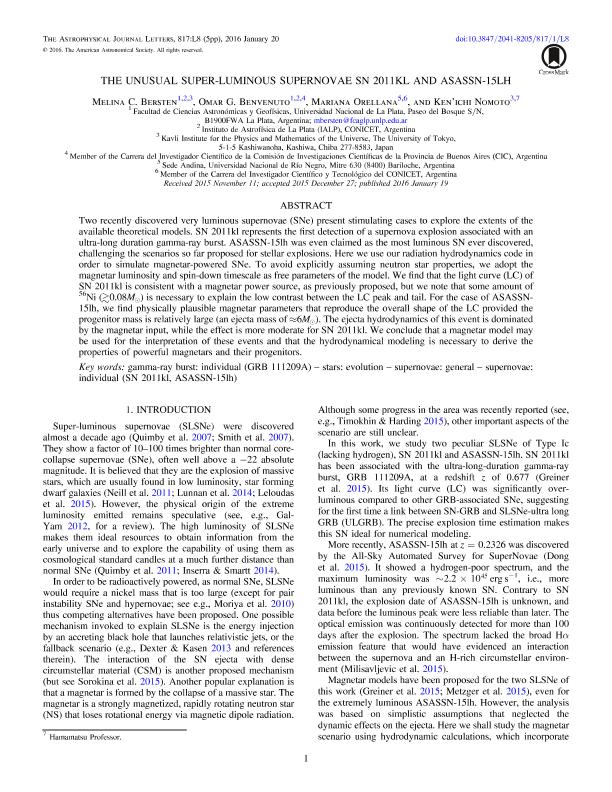Artículo
The Unusual Super-luminous Supernovae SN 2011kl and ASASSN-15lh
Fecha de publicación:
01/2016
Editorial:
IOP Publishing
Revista:
Astrophysical Journal
ISSN:
0004-637X
Idioma:
Inglés
Tipo de recurso:
Artículo publicado
Clasificación temática:
Resumen
Two recently discovered very luminous supernovae (SNe) present stimulating cases to explore the extents of the available theoretical models. SN 2011kl represents the first detection of a supernova explosion associated with an ultra-long duration gamma-ray burst. ASASSN-15lh was even claimed as the most luminous SN ever discovered, challenging the scenarios so far proposed for stellar explosions. Here we use our radiation hydrodynamics code in order to simulate magnetar-powered SNe. To avoid explicitly assuming neutron star properties, we adopt the magnetar luminosity and spin-down timescale as free parameters of the model. We find that the light curve (LC) of SN 2011kl is consistent with a magnetar power source, as previously proposed, but we note that some amount of 56Ni (> 0.08 Msun ) is necessary to explain the low contrast between the LC peak and tail. For the case of ASASSN-15lh, we find physically plausible magnetar parameters that reproduce the overall shape of the LC provided the progenitor mass is relatively large (an ejecta mass of ~ 6 Msun ). The ejecta hydrodynamics of this event is dominated by the magnetar input, while the effect is more moderate for SN 2011kl. We conclude that a magnetar model may be used for the interpretation of these events and that the hydrodynamical modeling is necessary to derive the properties of powerful magnetars and their progenitors.
Palabras clave:
Gamma Ray Bursts
,
Supernovae
,
Sn 2011kl (Supernova)
,
Asassn-15lh (Supernova)
Archivos asociados
Licencia
Identificadores
Colecciones
Articulos(IALP)
Articulos de INST.DE ASTROFISICA LA PLATA
Articulos de INST.DE ASTROFISICA LA PLATA
Citación
Bersten, Melina Cecilia; Benvenuto, Omar Gustavo; Orellana, Mariana Dominga; Nomoto, Ken’ichi; The Unusual Super-luminous Supernovae SN 2011kl and ASASSN-15lh; IOP Publishing; Astrophysical Journal; 817; 1-2016
Compartir
Altmétricas




